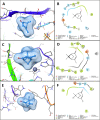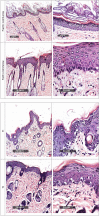Rosmarinus officinalis L. hexane extract: phytochemical analysis, nanoencapsulation, and in silico, in vitro, and in vivo anti-photoaging potential evaluation
- PMID: 35907916
- PMCID: PMC9338973
- DOI: 10.1038/s41598-022-16592-7
Rosmarinus officinalis L. hexane extract: phytochemical analysis, nanoencapsulation, and in silico, in vitro, and in vivo anti-photoaging potential evaluation
Abstract
A shift towards natural anti-aging ingredients has spurred the research to valorize traditionally used plants. In this context, Rosmarinus officinalis L. was evaluated for its photoprotective, antioxidant, anti-inflammatory, and anti-wrinkling properties. GC/MS and LC-ESI-HRMS based phytochemical profiling of rosemary leaves hexane extract resulted in the identification of 47 and 31 compounds, respectively and revealed rich content in triterpenoids, monoterpenoids and phenolic diterpenes. In vitro assays confirmed the antioxidant, anti-aging, and wound healing potential of rosemary extract along with a good safety profile, encouraging further development. A systematic molecular modelling study was conducted to elucidate the mechanistic background of rosemary anti-aging properties through the inhibitory effects of its major constituents against key anti-aging targets viz. elastase, collagenase, and hyaluronidase. Development of rosemary extract lipid nanocapsules-based mucoadhesive gels was performed to improve skin contact, permeation, and bioavailability prior to in vivo testing. The developed formulae demonstrated small particle size (56.55-66.13 nm), homogenous distribution (PDI of 0.207-0.249), and negatively charged Zeta potential (- 13.4 to - 15.6). In UVB-irradiated rat model, topical rosemary hexane extract-loaded lipid nanocapsules-based gel provided photoprotection, restored the antioxidant biochemical state, improved epidermal and dermal histological features, and decreased the level of inflammatory and wrinkling markers. The use of rosemary hexane extract in anti-aging and photoprotective cosmeceuticals represents a safe, efficient, and cost-effective approach.
© 2022. The Author(s).
Conflict of interest statement
The authors declare no competing interests.
Figures




Similar articles
-
Phytochemical Profiling of Flavonoids, Phenolic Acids, Terpenoids, and Volatile Fraction of a Rosemary (Rosmarinus officinalis L.) Extract.Molecules. 2016 Nov 19;21(11):1576. doi: 10.3390/molecules21111576. Molecules. 2016. PMID: 27869784 Free PMC article.
-
Metabolic Profiling by GC-MS, In Vitro Biological Potential, and In Silico Molecular Docking Studies of Verbena officinalis.Molecules. 2022 Oct 8;27(19):6685. doi: 10.3390/molecules27196685. Molecules. 2022. PMID: 36235221 Free PMC article.
-
Anti-inflammatory effects of ethanolic extract of Rosmarinus officinalis L. and rosmarinic acid in a rat model of neuropathic pain.Biomed Pharmacother. 2017 Feb;86:441-449. doi: 10.1016/j.biopha.2016.12.049. Epub 2016 Dec 22. Biomed Pharmacother. 2017. PMID: 28012923
-
Rosemary (Rosmarinus officinalis L.) Extract as a Potential Complementary Agent in Anticancer Therapy.Nutr Cancer. 2015;67(8):1221-9. doi: 10.1080/01635581.2015.1082110. Epub 2015 Oct 9. Nutr Cancer. 2015. PMID: 26452641 Review.
-
Rosmarinus officinalis L. (rosemary) as therapeutic and prophylactic agent.J Biomed Sci. 2019 Jan 9;26(1):5. doi: 10.1186/s12929-019-0499-8. J Biomed Sci. 2019. PMID: 30621719 Free PMC article. Review.
Cited by
-
Nanoformulated phytochemicals in skin anti-aging research: an updated mini review.3 Biotech. 2025 Jan;15(1):31. doi: 10.1007/s13205-024-04197-y. Epub 2025 Jan 3. 3 Biotech. 2025. PMID: 39760004 Review.
-
Rosmarinus officinalis and Skin: Antioxidant Activity and Possible Therapeutical Role in Cutaneous Diseases.Antioxidants (Basel). 2023 Mar 9;12(3):680. doi: 10.3390/antiox12030680. Antioxidants (Basel). 2023. PMID: 36978928 Free PMC article. Review.
-
Network pharmacology-based approach to investigate the molecular targets and molecular mechanisms of Rosmarinus officinalis L. for treating aging-related disorders.Biogerontology. 2024 Oct;25(5):793-808. doi: 10.1007/s10522-024-10122-w. Epub 2024 Jul 17. Biogerontology. 2024. PMID: 39017748 Review.
-
Exploring the antioxidant, antiglycation, and anti-inflammatory potential of Oroxylum indicum stem bark extracts.PLoS One. 2025 Jun 12;20(6):e0325795. doi: 10.1371/journal.pone.0325795. eCollection 2025. PLoS One. 2025. PMID: 40504850 Free PMC article.
-
Plant Extracts as Skin Care and Therapeutic Agents.Int J Mol Sci. 2023 Oct 22;24(20):15444. doi: 10.3390/ijms242015444. Int J Mol Sci. 2023. PMID: 37895122 Free PMC article. Review.
References
-
- Sim YY, Nyam KL. Application of Hibiscus cannabinus L. (kenaf) leaves extract as skin whitening and anti-aging agents in natural cosmetic prototype. Ind. Crops Prod. 2021;167:113491. doi: 10.1016/j.indcrop.2021.113491. - DOI
Publication types
MeSH terms
Substances
LinkOut - more resources
Full Text Sources
Miscellaneous

